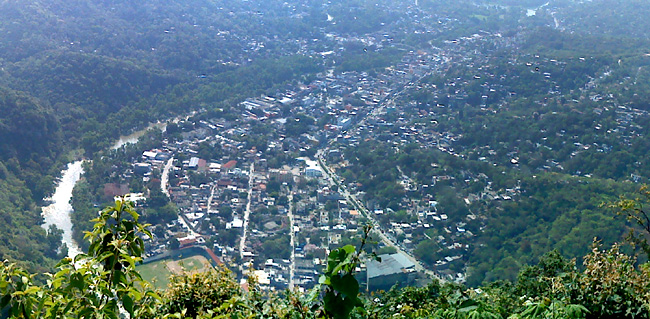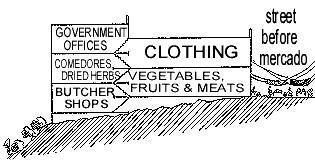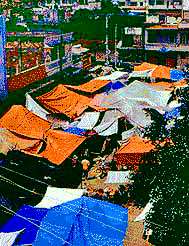
View of Tamazunchale in 2013; copyright free image courtesy of "Toxky" made available through Wikimedia Commons.
Tamazunchale, in the east-central state of San Luis Potosí, with a population of about 20,000, lies astride busy, two-lane Highway 85, which runs between Laredo, Texas and Mexico City. The town in situated in the hot, wet lowlands at the foot of the high plateau constituting most of interior Mexico. This means that Tamazunchale's oranges, bananas, and papayas find a ready market just upslope where it is too dry and chilly for such produce to grow.
Yet another economic advantage for Tamazunchale is that the overland trip from the Texas border to Mexico City is most comfortably made in two days; Tamazunchale lies at the journey's midpoint. Thus it's a good place to spend the night before reembarking on the highway which, just south of town, precipitously and tortuously climbs into the highlands.

As the vertical cross section at the left shows, Tamazunchale's Mercado Municipal, or Municipal Market, occupies a single large building. Shoppers entering the market from the street first enter a congested area occupied by stalls selling fruits, vegetables, and meats. Continuing to the back of the building, steps lead down to about a dozen butcher stalls lined next to one another.

The story above the ground floor specializes in dried herbs, and serves as home to a few comedores, or eateries. The next floor up specializes in clothing, and the next is occupied by offices of city government. It's possible to climb stairs to the roof, lean against a chain-link fence, and peer onto a multicolored sea of plastic tarpaulins suspended by wires over the streets below; this is the colorful scene portreyed at right. The tarps shelter selling locations filling and blocking the streets.
Streets around Tamazunchale's mercado are absolutely crammed with mobile and semimobile selling locations. During my most recent visit I saw next to the entrance three old, Nahuatl-speaking women sitting together, each selling edible nopal cactus pads in plastic bags. Next to them sat an eight-year old indigenous girl offering matches in boxes adorned with pictures of the Virgin of Guadalupe, and beyond her sat an old woman selling coffee beans in plastic bags. Farther on a man sold paper bags of roasted peanuts, and another man managed a blanket on which there was one heap of thick, pulpy bananas, and a pile of mangoes. During my visit mangoes were in season, and extremely delicious and cheap.
The streets immediately around Tamazunchale's mercado are so clogged with vendors and their wares that often it's hard to walk among them, and cars and trucks are banned altogether. On my most recent tour (around 1994) of the three most congested streets I counted 173 stands, which typically consisted of large, movable, wooden trays or tables. Here is a breakdown of what the stands were selling:
fruits and vegetables........................ 48
clothing..................................... 36
sandals and shoes............................ 13
herbs and spices............................. 9
hardware..................................... 9
toys......................................... 8
watches, jewelry, pens, etc.................. 7
cassette tapes of music...................... 6
handkerchiefs, thread, combs, knitting items. 6
dried peppers................................ 5
electrical appliances........................ 5
fruit drinks................................. 5
commercially produced candy.................. 3
plastic flowers.............................. 3
women selling tamales........................ 2
radios and TV's.............................. 2
coffee beans................................. 2
fresh flowers................................ 1
general groceries............................ 1
locally produced white cheese................ 1
undefinable category of miscellaneous items.. 1
As often is the case, Tamazunchale's vendors do not enjoy free use of the mercado building, or even of the surrounding public sidewalks. Inside the mercado building, stalls are rented for about US $8.35 per month; a spot on the street costs from seventeen to thirty-three cents a day. An office inside the mercado collects monthly bills, and each day an inspector circulates through the streets at random hours assuring that vendors have bought their vending tickets. All proceeds from ticket sales go into city coffers.
Regular stores in the vicinity of Tamazunchale's mercado are often stall- like, with roll-up, garage-type doors, enabling the public to enter all along the sidewalk. There is a hardware store, a couple of butcher shops, a clothing store, two or three bars, and a tortillaría, where tortillas are made and sold. There are no "Unisex Hair-Dressers" here, book stores, or jewelry shops; the market area is for basic commodities.
Lodging near the mercado also tends toward the basic, with more upscale hotels situated along the main highway one block upslope, and on the edge of town. The market area is also the place to purchase passage on rickety buses or microbuses (Volkswagen vans), or even regular pickup trucks, serving isolated indigenous villages off the main road. Buses run according to published schedules, microbuses according to rather informally stated schedules, and trucks leave when their owners feel ready to go. First-class bus stations are upslope, along the main highway.
Around Tamazunchale, in isolated villages off the main road, the main language spoken is not Spanish but rather the native-American indigenous language called Nahuatl. This was the language spoken by the Aztecs when they were in control of central Mexico upon the arrival of the Spanish in the early 1500s. Around Tamazunchale's mercado you hear a lot of Nahuat. If you meet an indigenous person on a trail out in the mountains, more than likely he or she will be heading to market, and well may have a hen or some fruits tucked into a bag to sell.
In and around most fair-sized Mexican mercados there is usually a particular area where comedores, or small eateries, are concentrated. In Tamazunchale, this lies at the end of the stall-choked street running in front of the mercado, down toward the river. It's an immensely pleasant place where people gossip and hang out.